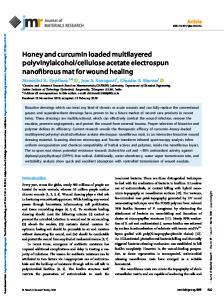Controlled Drug Release Formulation by Sequential Crosslinking of Multilayered Electrospun Gelatin Nanofiber Mat
- PDF / 471,064 Bytes
- 7 Pages / 432 x 648 pts Page_size
- 5 Downloads / 386 Views
Controlled Drug Release Formulation by Sequential Crosslinking of Multilayered Electrospun Gelatin Nanofiber Mat Anindita Laha, Saptarshi Majumdar and Chandra S Sharma Department of Chemical Engineering, Indian Institute of Technology Hyderabad, Kandi-502285, Telangana, INDIA ABSTRACT The major aim of the present study is to develop and explore the potential of large surface area electrospun polymer nanofabric as a carrier for controlled and sustained release, in particular for hydrophobic drugs. Gelatin (type A), FDA approved natural polymer was electrospun in a mixture of solvent (20% acetic acid in water) to yield long, continuous and uniform fibers with average diameter ~ 200 nm. Piperine was chosen as a model hydrophobic drug in this study. As gelatin is highly soluble in aqueous medium, we crosslinked electrospun gelatin nanofibers using saturated GTA vapor to increase the water resistive properties. For controlled release over a period of 12 h, we devised several strategies to vary the crosslinking conditions and accordingly understand their effect on drug release mechanism. One of such successful efforts was based on deposition of multiple layers of electrospun fabric by sandwiching between drug loaded gelatin nanofibers and without drug gelatin nanofibers from both sides. Not only the layer by layer deposition, we also crosslinked the different layer in the same sequential way. Sequential crosslinking using GTA vapor in different layers of the fabric, helped in uniform crosslinking throughout the thickness compared to crosslinking after final deposition in the form of a single layer. Effect of different crosslinking strategies was investigated in terms of surface morphology and drug stability. Finally, in-vitro release study was performed maintaining the physiological conditions mimicking GI tract to analyze the effect of crosslinking on the drug release profile. The in-vitro studies concluded that the controlled drug release can be achieved by tuning the thickness of individual fabric layer followed by their sequential crosslinking, which finally affects the diffusional barrier for drug release. Interestingly, we also found that only 6 min exposure to saturated GTA vapor is sufficient to provide the required drug release in contrast to up to 24 h as reported in literature. This finding also addresses the toxicity problem associated with the use of GTA as a cross-linker. INTRODUCTION The main challenge of any drug delivery system (DDS) is to deliver pharmaceutical agent or drug in a predetermined manner for a defined time interval according to the treatment requirements [1]. Polymer based DDS has received considerable attention because of its therapeutic efficacy and lower side effect. Researcher has fused polymer science and technologies in order to develop different DDS for biomedical and pharmaceutical applications [2-6]. One such development is in the area of using polymeric nanofiber as DDS due to their large surface area and porosity [7-8]. Electrospinning is a straightforward and cost effective way t
Data Loading...











